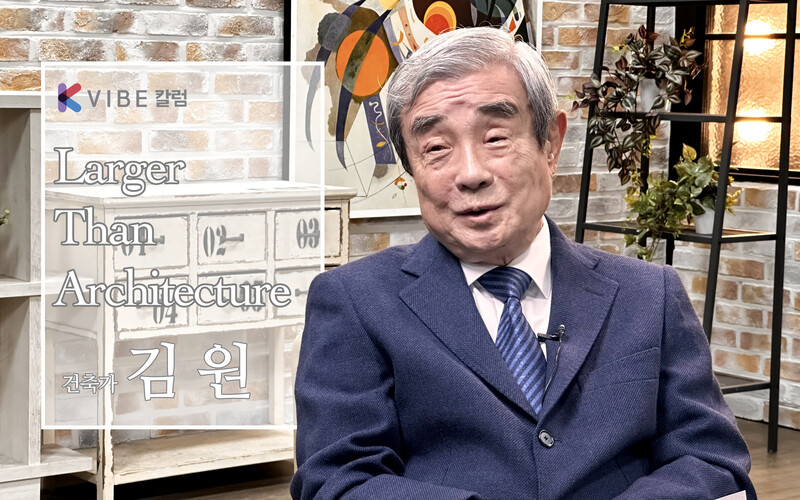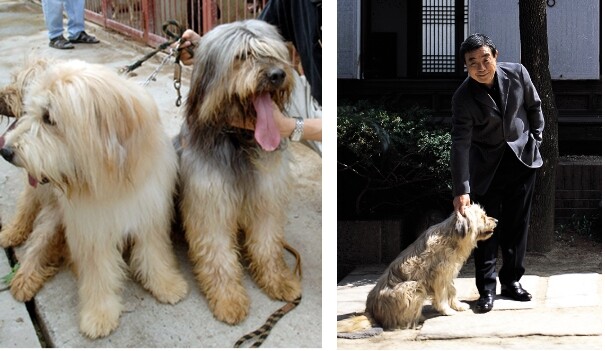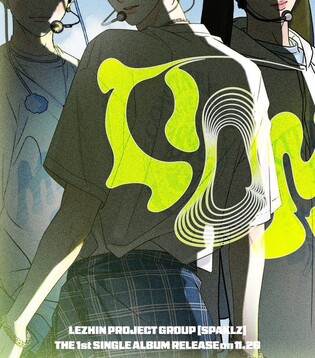*Editor’s note: K-VIBE invites experts from various K-culture sectors to share their extraordinary discovery about the Korean culture.
[Larger Than Architecture] Chapter 1. This World We Live In
Ep. 4. About Aengdoo
By Kim Won (Master K-architect)
 |
"Aengdoo" lived with our family for 13 years before passing away to heaven last month. When she came to our house at two months old, she was a complete bundle of fur, resembling a ball of yarn crawling around. When I was young, my mother used to knit every night, and the way the round ball of yarn rolled around with her hand movements was exactly how Aengdoo looked. So, my daughter Ji-young named her "Aengdoo," after a pretty heroine from a popular TV drama at the time.
There is a saying that dogs should be brought home before they are two months old to recognize their owner for life and follow only that person. Perhaps for this reason, Aengdoo displayed incredible affection and loyalty, treating us like her true family and ignoring everyone else. Contrary to our worries that she might cry, refuse to eat, and miss her mother, she quickly adapted. She drank milk from a bottle, slept well, played energetically, and showed boundless cuteness and affection, seemingly having forgotten her mother's memories completely.
Aengdoo was a "Sapsal dog." Professor Ji-Hong Ha of Kyungpook National University's Department of Life Sciences succeeded in restoring this Korean native breed in 1990 after long efforts, starting with eight first-generation Sapsal dogs. My godson, Chairman Won-pyeong Lee, bought and raised several Sapsal dogs at his Gonjiam farm from that lineage. Aengdoo, born to that family, was presented to her owner's godfather. Thus, she was a blessed dog born into the best bloodline among her kind. The "Gyeongsan Sapsal dog" breed was designated as Natural Monument No. 368 in 1992.
The first few months Aengdoo was with us were happy times for our family. We were delighted just to look at her, perhaps because she was so precious. I even took her to the office with me on some days because I couldn't bear to leave her behind in the morning. On such days, the office staff took turns looking after her. I also proudly talked about her to everyone, which led me to study more about Sapsal dogs.
 |
In Korea, the most well-known native dogs are the Jindo and the Pungsan. Recently, the Genomic Resource Center at the Korea Research Institute of Bioscience and Biotechnology decoded the DNA of the Jindo dog, revealing that out of over 400 dog breeds worldwide, only 78 breeds have distinguishable genetic information (mitochondrial DNA). The Jindo's 3 billion genetic pieces make it the second breed worldwide after the German Boxer to be fully decoded, proving it is a purebred Korean native dog. The Jindo is distinct from any other breed, including the Japanese Akita.
We now easily think of the Jindo as the representative Korean native dog, but its prominence resulted from Japanese efforts during the occupation to show that Koreans and Japanese were originally of the same race, raising the Jindo's status by comparing it to the Akita and systematically eradicating the Sapsal dog, which had been the main native breed. It is estimated that around 300,000 Sapsal dogs were slaughtered to provide fur for Japanese troops in Manchuria.
Two Sapsal dogs live on Dokdo Island today, gifted by Professor Ji-Hong Ha in 1998. His dedicated efforts have been crucial in preserving the nearly extinct Korean Sapsal dog. In his book "Our Sapsal dog" (2001), he details the process of saving the breed from extinction. The term "Sapsal dog" originally means "a dog that drives away misfortune," with "Sap" meaning "to scoop out" or "eliminate" and "Sal" meaning "evil spirit." Hence, Sapsal dog was preferred from the Three Kingdoms period through the Joseon Dynasty for warding off evil spirits.
Sapsal dogs are known for their long fur, resembling lions, earning them the nickname "lion dog." Sapsal dogs were companions to Buddhist monk Kim Gyo-gak from Silla, and even appear in paintings in Chinese temples. They were also commonly depicted in Joseon-era talisman paintings.
Japan also has wooden or stone animal figures at shrine entrances called "Koma-inu" (Korean dogs), brought from Korea and related to Sapsal dogs. During the Japanese occupation, most Sapsal dogs were slaughtered, and only remote areas had any left post-liberation. Professor Ha's efforts to bring Sapsal dogs to Dokdo for a ritual are significant.
Another notable native dog is the "Donggyeong Dog" from Gyeongju, also called "Donggyeong" (Eastern Capital) Dog, known for its short or nonexistent tail and loyalty. Like the Sapsal dog, the Donggyeong Dog was nearly wiped out by the Japanese. Gyeongju City is now working to restore this breed, much like the efforts for the Sapsal dog by Kyungpook National University.
The Sapsal dog's long fur made stories of it saving owners from fires believable, as it could carry water in its fur. However, Aengdoo disliked getting wet because her fur took too long to dry.
We also had a Jindo dog named "Jindo," brought to us by a neighbor who wanted a purebred. Initially, we worried Jindo might harm Aengdoo, but later, we had to ensure they didn't become romantically involved, as Aengdoo was free to roam while Jindo was mostly leashed.
Jindos and Sapsal dogs have distinct characteristics. Jindos are strong and fierce, while Sapsal dogs are gentle but can be fierce when provoked. Jindos are like taekwondo, disciplined and straight, while Sapsal dogs are like traditional Korean wrestling, soft but strong. Jindos guard fiercely, while Sapsal dogs, like Aengdoo, observe quietly and alert their owners of any unusual activity.
 |
Aengdoo never ran out even if the gate was open, knowing it displeased us. Unlike Jindo, who would run off and return only when tired or hungry. This allowed Aengdoo to roam freely without a leash. Watching her run with her mane flowing in the wind was a beautiful sight.
We once tried to find a mate for Aengdoo, visiting a well-known male Sapsal dog in Insa-dong. However, Aengdoo showed no interest and even bit the owner’s wrist, fleeing. Thus, Aengdoo remained a maiden all her life, which I regret and feel guilty about.
About two months before her death, Aengdoo became very weak, barely able to walk or eat. The vet diagnosed her with widespread liver cancer. At about 13 years old, she struggled to do anything. We decided on euthanasia after consulting the vet. With an intravenous injection, our beloved Aengdoo peacefully closed her eyes.
I still sometimes imagine her sitting by the glass door, waiting for me to play with her. She was a cute and lovable dog. I often wonder why she so adamantly rejected God's design, thinking it might be my fault for not giving her enough time to bond.
Aengdoo brought us much joy. My wife, despite her complaints, always made sure Aengdoo had food. I often boasted about her intelligence and bravery, and we all felt secure knowing Aengdoo was watching over us.
(C) Yonhap News Agency. All Rights Reserved


































